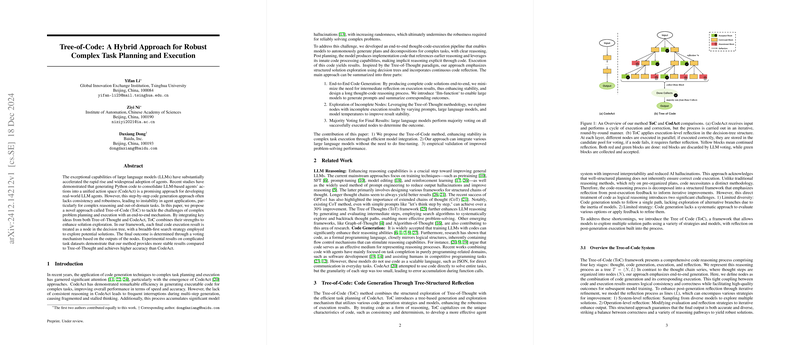An Analysis of Tree-of-Code: A Hybrid Approach for Robust Complex Task Planning and Execution
The paper presented introduces a novel method named Tree-of-Code (ToC), which addresses the critical need for robust complex task planning and execution within LLMs. This method synthesizes ideas from the Tree-of-Thought and CodeAct paradigms to improve consistency and robustness in decision-making processes. The focal point of the research is on enhancing solution exploration in task execution, especially where traditional code generation frameworks exhibit instability, particularly for complex reasoning and out-of-domain tasks.
Overview and Methodology
Tree-of-Code (ToC) implements a structured, decision-tree-based exploration through code generation, facilitating robust execution by transforming final code outputs into decision nodes. It employs a breadth-first search (BFS) strategy to identify optimal solutions, incorporating a voting mechanism to determine the final outcome based on the consistency of node outputs. This approach is contrasted with traditional linear execution models, which often struggle with fragmented reasoning due to step-by-step code generation in LLM-based agents.
The framework comprises an end-to-end thought-code-execution pipeline, allowing for autonomous plan generation and task decomposition. This process is intended to enable more coherent reasoning by translating implicit reasoning into explicit code, which is then executed to validate solutions. Additionally, the reflection process, characterized by continuous code improvement, is embedded within the execution framework to mitigate the randomness and hallucinations prevalent in standard code generation methods.
The ToC method is detailed in three stages:
- End-to-End Code Generation: ToC minimizes intermediate reflections on execution by generating complete code solutions through a designed long thought-code reasoning process. This contrasts with methodologies that generate code in fragments, resulting in a potent improvement in stability.
- Exploration of Incomplete Nodes: ToC enhances solution stability by exploring nodes with incomplete execution outcomes via variations in prompts, different LLMs, and model temperatures.
- Majority Voting for Final Results: The model aggregates outputs from successfully executed nodes through majority voting, maximizing accuracy and reliability.
Experimental Results and Implications
The experimental evaluation indicates that the Tree-of-Code method significantly improves both robustness and accuracy in executing complex tasks, outperforming existing models like Tree-of-Thought and CodeAct. Using a benchmark dataset of intricate task scenarios, Tree-of-Code demonstrated a marked improvement in accuracy by 7.2% over CodeAct, primarily attributed to its capability for comprehensive exploration and reflection within a task.
Furthermore, ToC's adaptability, due to its end-to-end integration with existing LLM infrastructure without requiring additional fine-tuning, suggests promising scalability and potential applications in real-world AI systems. By treating code as an explicit reasoning form, ToC also provides increased interpretability, a valuable asset in domains demanding transparency and reproducibility.
Conclusion and Future Directions
Tree-of-Code exemplifies a significant stride towards robust and consistent task execution in complex environments for LLMs. The integration of structured decision-making strategies into code generation processes illustrates a compelling avenue for future exploration, where leveraging diverse model strategies and systematic feedback could further enhance problem-solving capabilities in LLM applications. Future research could explore refining this method, particularly in integrating adaptive learning components into the reflection process, thereby enriching robustness and the scope of applicability in varied domains.
In summary, Tree-of-Code reinforces the emergent need for a balanced approach combining code and thought processes in AI task execution, providing a resilient framework that inherently addresses the limitations observed in precedent methodologies. Its implications span both theoretical refinement of LLM capabilities and practical enhancements in deploying AI agents for complex and real-time problem-solving scenarios.
